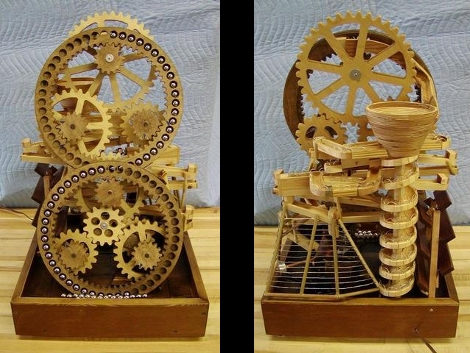[Denha’s] been building marble machines for years and decided to look a back on some of his favorite marble-based builds (translated). There’s a slew of them, as well as some thoughts about each. Our favorite part is the digital simulations of the projects. For instance, the image above shows a flip-flop marble machine that was built in a physics simulator. This makes it a lot easier to plan for the physical build as it will tell you exact dimensions before you cut your first piece of material. Both of these images were pulled from videos which can be seen after the break. But this isn’t the most hard-core of pre-build planning. SolidWorks, a CAD suite that is most often used to design 3D models for precision machining, has also been used to model the more intricate machines.
marble17 Articles
5/8″ Ball Bearing Playground

This kinetic sculpture is a ball bearing’s paradise. Not only do they get a cushy ride around two lift wheels but there’s a variety of enjoyable obstacles they can go down. The first is a vortex made from a wooden flower pot which sends the balls randomly down one of two possible exits. From there it’s on to enjoy a ride on a flip-flop, a divide-by-three (takes weight of three marbles before it dumps them all), a zig-zag track, or a divide by twelve mechanism. We’re sure this is a riveting read, but don’t miss the video after the break where [Ronald Walter] shows it in action and takes it apart to illustrate the various features.
If you’re wondering about the digital logic terms used, we’ve seen wooden devices that use these concepts in the past.
Binary Adder Will Give You Slivers

A while back we looked at [Matthias’] one-pin dot matrix printer. Now we’re jumping over to his woodworking website to feast on his wooden binary adding machine. His creation uses glass marbles as the data for this device. A resolution of up to six bits can be set on the top of the adder, then dropped into the machine as one number. With each new drop, the number is added to the total stored in the machine. The device is limited to totals less than 64. If a larger number is enter, the device wraps around back to zero by dumping the 7th bit off the end. He’s even got a master clear that allows you to easily read the stored total and evacuate the “data” from the machine.
This has quite a few less wires than the last binary adder we looked at… wait, it has no wires! But we still love it. A physical representation of what is going on with binary math really helps grasp what the magic blue smoke inside those silicon chips is all about. Don’t miss his video walk through of the adding machine embedded after the break. Can’t get enough of marbles interacting with wood? He’s got a few more projects you might enjoy. Continue reading “Binary Adder Will Give You Slivers”











